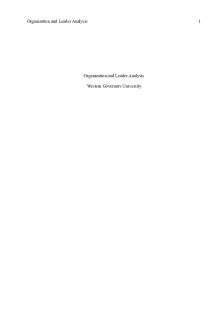PA Intro to Humanities - Grade: Pass PDF

| Title | PA Intro to Humanities - Grade: Pass |
|---|---|
| Author | Amy Owens |
| Course | Introduction to Humanities |
| Institution | Western Governors University |
| Pages | 2 |
| File Size | 79.7 KB |
| File Type | |
| Total Downloads | 9 |
| Total Views | 148 |
Summary
Download PA Intro to Humanities - Grade: Pass PDF
Description
Venus Devouring his Son from C100 Task Works List Amy Owens
A1. Historical Events and/or Innovations Francis de Goya’s Painting Saturn Devouring his Son is from the Romantic period which spanned from the late 18th century to the middle of the 19th century. The 18th and 19th centuries were a time of revolution. The Industrial Revolution took place from the middle of the 18th century into the middle of the 19th century and saw great technological advancement. Steam power was developed which brought about the invention of the steamboat as a new mode of transportation. There was also the American Revolution where major themes in literature emerged such as nationalism, individualism, and heroism. Finally, there was the French Revolution where the philosophies of the Enlightenment empowered the citizens of France to organize the revolution and defend their basic human rights. (MindEdge, 2019) A2. Work Analysis Saturn Devouring his Son is a perfect example of exoticism and the interest in the strange and unique. You can see the theme in this artwork through the very unconventional use of such a graphic scene in which Saturn, fearing he would be overthrown by one of his children, ate them at birth. This painting depicts a crazed Saturn who already has eaten the head and right arm of his son and is taking a bite out of the left arm. You can see the ferocity of the act represented in the wild appearance of Saturn and in the whites of his knuckles from his hands being clenched around his victim. This piece of art most definitely keeps with the theme of exoticism as it was very new and unusual at the time and can still draw interest even today.
A3. Contribution to Humanities Francisco de Goya was one of Spain’s greatest artists during the Romantic period. He contributed to the humanities in many ways, believing that the most important thing was to draw what he saw and not follow societal norms. He brought real subject matter and his interpretations to the canvas. “Goya was one of the greatest printmakers of all time, and is famous for his achievements in etching and aquatint. The subject matter of his etchings veers from dreamlike to grotesque, documentary to imaginary, and humorous to harshly satirical.” (Francisco Goya) When he was young he was commissioned to paint churches, tapestries, and various other works. He even became the Adjunct Director of Painting at the Spanish Royal Academy. In his early years, “Goya became a
sharp observer and practiced various styles.” (Francisco de Goya) After falling ill, he lost his hearing and part of his sight and his art took a turn from colorful and happy to dark and exotic. His late work brought what was known as the Black Paintings which was a collection of 14 paintings that became regarded as some of his most impressive work and are now displayed in the Prado in Spain. (Francisco de Goya)
References Francisco de Goya: Biography & Painter. (n.d.). Retrieved March 31, 2020, from https://schoolworkhelper.net/francisco-de-goya-biography-painter/ Francisco Goya Paintings, Bio, Ideas. (n.d.). Retrieved March 31, 2020, from https://www.theartstory.org/artist/goya-francisco/ MindEdge, Inc. (2019). Introduction to Humanities. Waltham, MA: MindEdge, Inc.
The Editors of Encyclopedia Britannica. (2020, March 27). Romanticism. Retrieved March 31, 2020, from https://www.britannica.com/art/Romanticism...
Similar Free PDFs

Shopee-pass - Grade: B
- 23 Pages

MKT portfolio - Grade: pass
- 6 Pages

Task 4 - Grade: pass
- 5 Pages

Task 2 - Grade: Pass
- 14 Pages

TASK 3 - Grade: pass
- 3 Pages

Task 4 - Grade: pass
- 5 Pages

C455 Task 1 - Grade: pass
- 4 Pages

C820 task 3 - Grade: pass
- 3 Pages

C207 Task 2 - Grade: Pass
- 3 Pages

C121 Task 1 - Grade: Pass
- 8 Pages

C455 Task 4 - Grade: Pass
- 5 Pages

C304 task 3 - Grade: pass
- 2 Pages

AVM1 Task 2 - Grade: Pass
- 2 Pages

Task 3- KMM1 - Grade: pass
- 3 Pages

C109 (revised) pdf - Grade: pass
- 3 Pages
Popular Institutions
- Tinajero National High School - Annex
- Politeknik Caltex Riau
- Yokohama City University
- SGT University
- University of Al-Qadisiyah
- Divine Word College of Vigan
- Techniek College Rotterdam
- Universidade de Santiago
- Universiti Teknologi MARA Cawangan Johor Kampus Pasir Gudang
- Poltekkes Kemenkes Yogyakarta
- Baguio City National High School
- Colegio san marcos
- preparatoria uno
- Centro de Bachillerato Tecnológico Industrial y de Servicios No. 107
- Dalian Maritime University
- Quang Trung Secondary School
- Colegio Tecnológico en Informática
- Corporación Regional de Educación Superior
- Grupo CEDVA
- Dar Al Uloom University
- Centro de Estudios Preuniversitarios de la Universidad Nacional de Ingeniería
- 上智大学
- Aakash International School, Nuna Majara
- San Felipe Neri Catholic School
- Kang Chiao International School - New Taipei City
- Misamis Occidental National High School
- Institución Educativa Escuela Normal Juan Ladrilleros
- Kolehiyo ng Pantukan
- Batanes State College
- Instituto Continental
- Sekolah Menengah Kejuruan Kesehatan Kaltara (Tarakan)
- Colegio de La Inmaculada Concepcion - Cebu
